The Banggai area in Sulawesi is one of Indonesia’s most underrated places, with an amazing blue lake called Paisupok and other good things to see including beaches, caves, waterfalls, and wildlife.
This is a big area that includes three different regencies — Banggai, Banggai Islands, and Banggai Laut — so it’s a bit more complicated than visiting other places in Sulawesi. My wife is Indonesian so that helped a lot.
We visited the Banggai islands independently, arranging our own hotels and transport for each step of the journey, and this blog post will explain how you can too. I’ll also share some contacts for local tour guides if you want to join a group or do a private tour to make it easier.
Either way, Banggai has some wonderful sights and it’s well worth a visit if you’re already planning a trip to Sulawesi!
Banggai Islands Itinerary Day 1: Luwuk To Peleng
• Fly To Luwuk
This itinerary for the Banggai islands starts and ends in Luwuk, which is a town of about 35,000 people in central Sulawesi.
There are direct flights to the Luwuk airport (LUW) from Makassar in South Sulawesi, or Manado in North Sulawesi. Otherwise, you can hire a driver and go overland to Luwuk from Ampana after visiting the Togean islands, which is another nice place to visit in Sulawesi.
If you’re flying to Luwuk from Bali, Jakarta, or somewhere else in Indonesia, then you’ll have to transit in Makassar or Manado on the way to Luwuk. You can shop for flights on Skyscanner.
• Take The Ferry To Peleng
Once you arrive in Luwuk, you can take the public ferry from Luwuk People’s Port (‘Pelabuhan Rakyat’) over to Leme Leme on Peleng island. It departs every day at 2 PM and the journey takes 2 hours, although it usually leaves an hour late (i.e. Indonesian rubber time).
Tickets can be bought on the spot for 54k Rupiah (~$3 USD) per person. This is a big wooden boat that carries about 50 to 100 passengers. It has bunks and benches to sit on, but they’re not very comfy. If you want more privacy, you can rent a small room for two people which has bunk beds and a fan. This costs an extra 50k Rupiah per room.
Alternatively, you can arrange a speedboat to take you over to some of the best sights on Peleng island, including Paisu Pok Lake & Poganda Beach. In that case, the journey takes 1 to 2 hours from Luwuk, and you can sometimes see dolphins on your way over.
A day tour with a private speedboat like this will set you back anywhere from 1.5 to 4 million Rupiah (~$100 to $250 USD) for the roundtrip, so it’s not cheap, but it’s quicker than the ferry and it could be economical in some cases if you’re traveling with friends to share the boat cost.
Regardless of whether you choose the ferry or speedboat, the sea is very calm between Luwuk and Peleng island, so I wouldn’t expect waves to ever be an issue for crossing in normal situations.
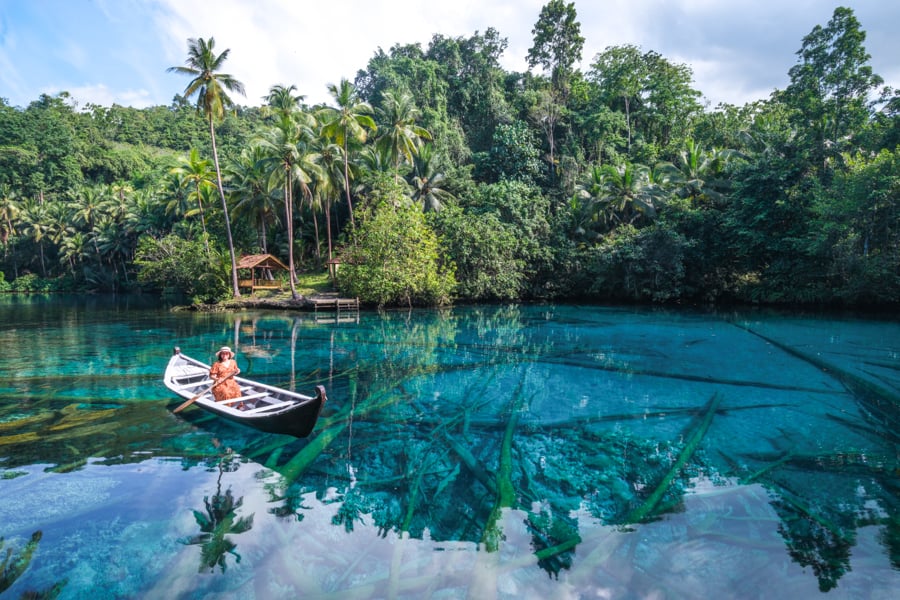
Floating in a boat on Paisu Pok Lake
• Stay Overnight In Peleng
By the time we arrived in Peleng, it was already past 5 PM and the sun was setting. We were anxious to go see Paisu Pok Lake, but there wasn’t enough time left on our first day.
We stayed at Novpitri Homestay, which is right by the harbor in Leme Leme. The rooms are very basic, with a fan, squat toilet, cold water bucket for showers, and electricity from approximately 6 PM to 6 AM.
They only have one air-conditioned room, so it’s a good idea to book this in advance if you want it. They’re slow to respond on WhatsApp even if you speak Indonesian. Don’t expect luxury at the homestay, but if you’re out exploring all day it’s fine. We already knew this would be the roughest place we’d stay on our Banggai trip, so two nights here was no problem.
The normal rate is 180k Rupiah per night for the A/C room, or 120k for the fan room. Hopefully they’ll add mosquito nets soon. The family was helpful and cooked supper for us, which was also very cheap and good: rice, veggies, omelets, fried tofu, and chicken.
If you want to stay closer to the Paisu Pok Lake, there are a bunch of very basic homestays in the Luk Panenteng village, which is right by the lake. If you stay there, you can walk to the lake and swim every day.
Before going to bed, we arranged a scooter rental from the homestay so we could spend the next day going to the lake and the beach. They had it ready and waiting for us by the time we went to sleep!
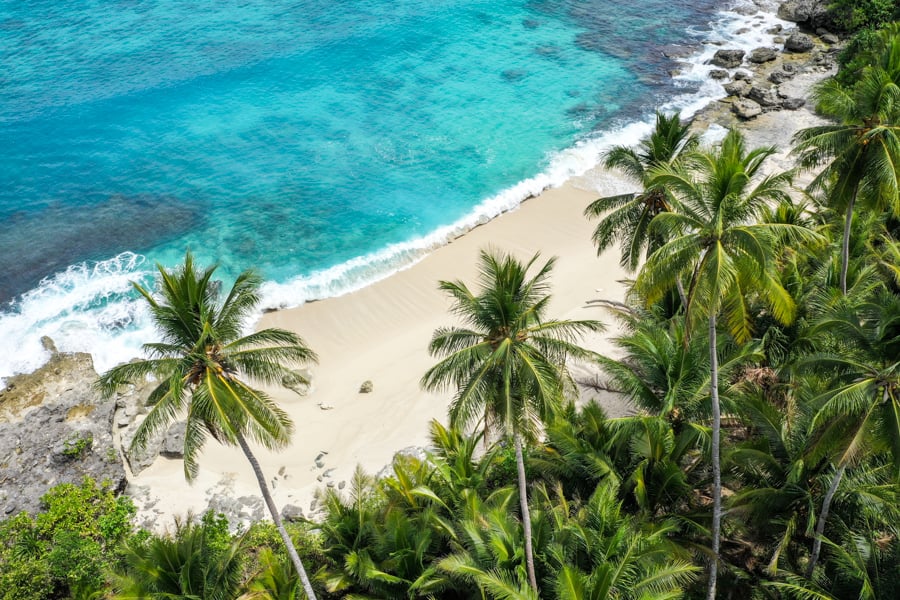
Banggai has lots of little private beaches like this one near Mandel Beach.
Banggai Itinerary Day 2: West Peleng Island
• Paisu Pok Lake
Paisu Pok Lake is a beautiful blue lake in Peleng island, and it’s one of the main highlights of the Banggai area.
You can rent a small boat, canoe, or standup paddleboard for exploring the lake, or you can swim and snorkel in it. The color of the water is amazingly blue. It’s just as nice as it looks in the photos.
Paisupok is a 1 hour drive from Leme Leme because some parts of the road are broken and you have to slow down to pass them safely. There’s very little traffic on the road and it’s easy to find the lake. You can’t get lost, especially if you download an offline map beforehand.
I wrote a complete travel blog post about our visit to Paisupok, with lots of tips and photos, which you can check out in the link below.
Read More: Paisu Pok Lake
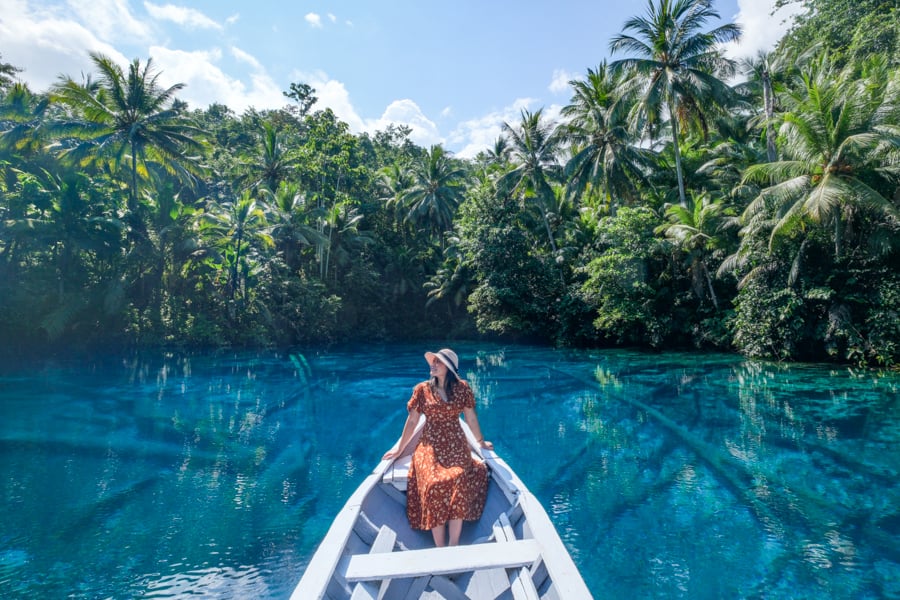
Paisu Pok Lake in the Banggai islands of Sulawesi.
• Paisu Batango
The next stop on Peleng island is a little lagoon called Paisu Batango, which is a 5 minute drive from the lake. On maps it’s marked as ‘Luk Bath Panenteng.’
The name Paisu Batango means ‘trunk water’ or ‘water from a tree trunk’ since the lagoon is fed by a natural spring. Sadly the locals use this place for bathing and washing their clothes with detergent, which messes up the clarity of the water a bit.
The cold spring water has a nice turquoise color even though the deeper side of the lagoon mixes with salt water from the ocean.
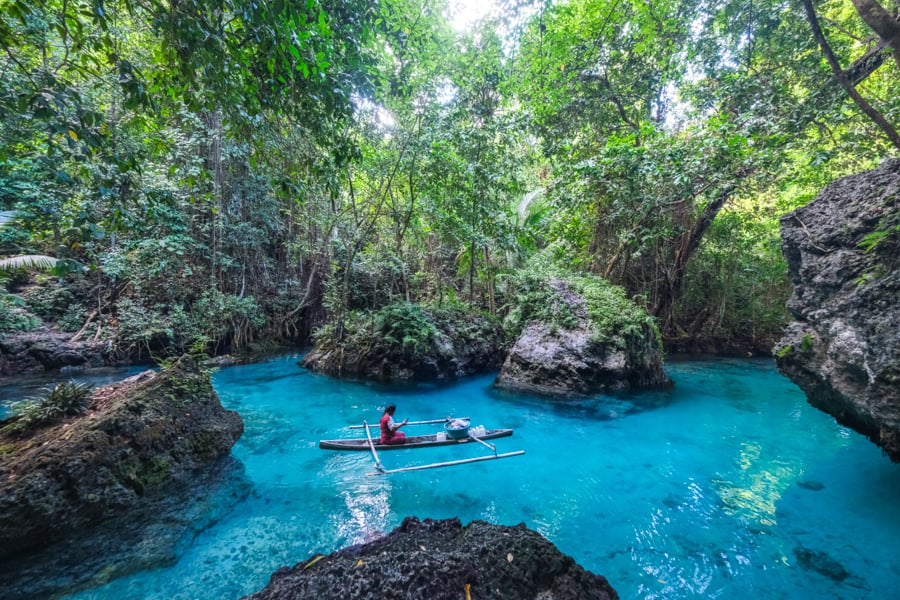
Paisu Batango
• Poganda Beach
The third place to visit on Peleng island is a white sand beach called Pantai Poganda, which is approximately halfway between Leme Leme and the lake. From Paisupok, it’s just a 30 minute drive.
This is a peaceful beach with calm water and palm trees, and it’s a good spot for snorkeling. We were surprised to see lots of starfish, even without snorkeling. There are a bunch of them sitting in the shallow water near the beach.
It’s a good beach for both sunrise and sunset, depending on the time of year. There are also several swings and a pier where you can sit and relax.
There’s a white sand beach near the lake called Pantai Poganda
The pier at Poganda Beach
• Stay Overnight In Peleng
After spending all day sightseeing, we went back to Leme Leme and spent another night at the Novpitri Homestay.
Before going to bed, we arranged a driver with a van for sightseeing and then a transfer to Salakan the next day.
The cost was going to be 850k Rupiah (including petrol and driver) to take us directly to Salakan, or 1.2 million Rupiah to go visit two caves in southwest Peleng before going to Salakan. We decided to see the caves!
Banggai Itinerary Day 3: Caves & Salakan
• Driving To The Caves
Our driver Anto met us at 6:30 in the morning and then we started our day trip. First, we had to fill up on petrol, which took about 45 minutes since we had a hard time finding a place that was open this early.
The journey to the caves is a scenic drive with hills, jungles, palm forests, and ocean views. This involved about 5 hours of driving — 2 hours to the caves, and then 3 hours to Salakan — so we were happy to be in a car instead of a scooter.
As we found out, the Peleng roads are paved but they’re broken in many places. You could do it with a scooter, but I wouldn’t recommend it unless you have some experience.
The best time to photograph the caves is in the morning, when the sun is right. We got to the first cave (Gua Susendeng) at 9 AM, and this was perfect.
• Gua Susendeng
The first cave we visited was Gua Susendeng, a shallow limestone cave with a high ceiling and a blue pool at the bottom. To reach the cave from where we parked at the main road, it was a 10-15 minute downhill walk on a grassy path.
The walk down is easy, but going back is a bit harder because it’s all uphill and there’s no shade to escape the sun. Once you get to the mouth of the cave, there’s a concrete stairway in good condition that goes down to the blue pool.
The color of the water is amazing and it would be fun to swim here. Our driver said the cave has been explored by scuba divers, and there’s apparently an underwater tunnel at least 200 meters long!
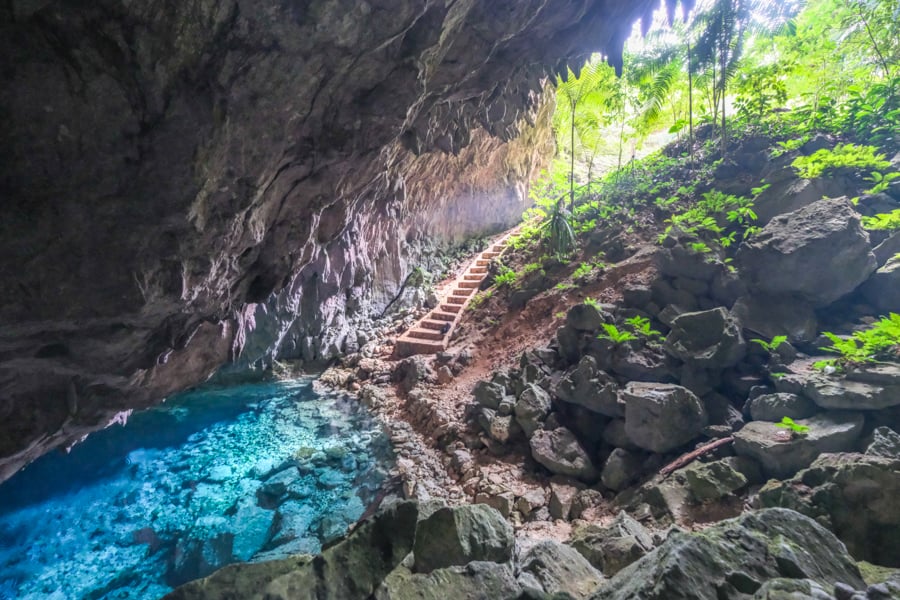
• Gua Bab’banang
From the first cave, it’s only a 10 minute drive to the next cave, which is called Gua Bab’banang. Then, there’s a short 5-10 minute walk through the forest, where you can see lots of blue-tailed lizards and also some nice bright green lizards.
Sadly the locals have already built an ugly concrete bathroom right by the mouth of the cave, and there was a lot of trash in the forest too. Hopefully with the increased interest from tourism, they’ll have some motivation to keep this area clean. The cave itself is very nice!
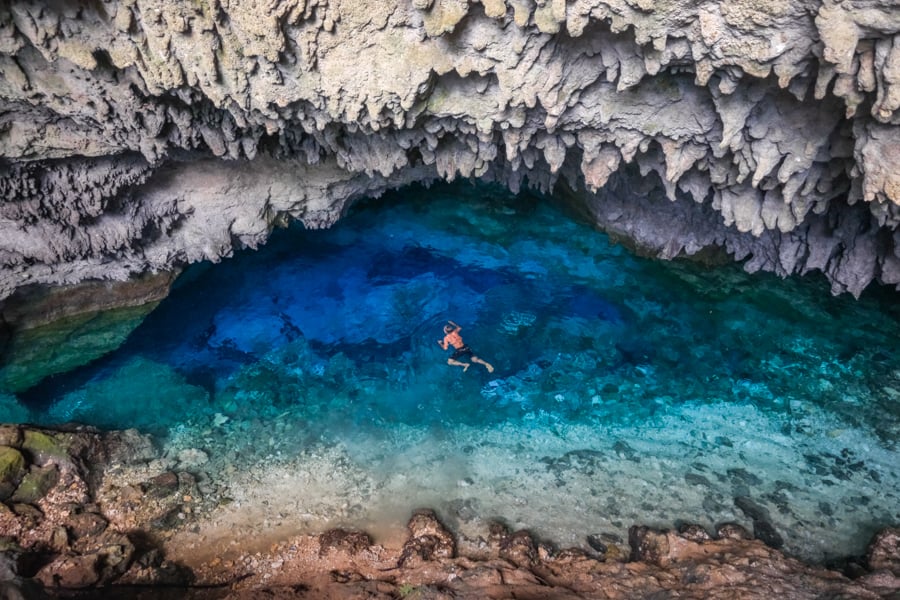
• Drive To Salakan
After we got done at the caves, it was a 3 hour drive to the town of Salakan. We hoped to stop for lunch on the way there, but we didn’t see anything that looked worthwhile, so we decided to wait and have a late lunch in Salakan.
• Stay Overnight In Salakan
We spent one night in Salakan. It’s a small town with only 2,000 people, but there are several comfortable hotels and restaurants to choose from.
We stayed at Wisma Sidapore Teluk Bayur, which had clean A/C rooms and free breakfast. Other options are Wisma Sidapore Jalur Dua (owned by the same people) or Wisma Alfrend Salakan.
You can make a booking with any of these hotels via WhatsApp. They can also arrange a scooter rental, or a car and driver.
Banggai Itinerary Day 4: Salakan To Banggai Laut
• Bone Pompon Beach
For our 4th day in Banggai, we hired a driver from Salakan to take us to several beaches and then drop us at the harbor in Tobing so we could go to our next destination, Banggai Laut island. This time the cost was 550k plus petrol, so the total came to 800k Rupiah.
The first beach we visited was called Bone Pompon, and it was nice. It’s a 30 minute drive from Salakan. At Pompon, you can hire a small boat to visit several hidden beaches, including a little secret island called Pulo Tambun, which has a white sand beach.
However, we were in a hurry to get to our next beach (Mandel) since it’s one of the spots that has started to go viral on Instagram.
• Mandel Beach
Mandel Beach is a white sand beach more than a kilometer long, and it’s probably the most beautiful beach in all of central Sulawesi.
This beach has extremely white sand and turquoise water. Even though it’s only a 1 hour drive from Salakan, we only saw two other people there! It was amazing to have it all to ourselves. I expected it to be crowded like Paisu Pok, but since it’s a bit harder to reach, I think that has kept the crowds away.
It’s a wonderful beach and I hope it doesn’t become overdeveloped. There was some rubbish on the beach, so we filled two small bags with trash and tipped our driver for helping to dispose of it in town.
Mandel Beach is one of the most beautiful beaches in the Banggai islands.
• Bone Uluno Abason Beach
The third beach we visited was called Bone Uluno Abason, and it was a 30 minute drive from Mandel. It’s a long beach with brown sand.
This was a nice beach, but there was trash everywhere. It was sad to see. This may have been partly because of the rainy season, because I’ve seen pictures of this beach where there was no trash at all, so your experience may vary depending on when you go.
• Boat To Banggai Laut
After we were done seeing beaches, we drove another hour to the harbor in Tobing, which is the best spot to get a boat transfer to Banggai Laut island. Another option is the harbor in Kalumbatan, but it’s more expensive.
From Tobing, it’s easy to get a boat ride to Banggai Laut. The cost was 80k per person because we shared it with four locals and their kids. The last shared boat goes at 5 PM, so if you show up later than that you might have to pay more to charter a boat.
The boat ride is safe and comfortable, and only takes 15 minutes to get to Banggai Laut. It’s a small speedboat but there’s plenty of room for luggage.
• Overnight In Banggai Laut
Once you arrive in Banggai Laut, there are hotels and restaurants within walking distance from the harbor.
We stayed at Hotel Banggai, which was a little pricey by Indonesian standards, but it was comfortable and had free breakfast. The owner Refly was extremely kind and helpful for every aspect of our stay on the island, so that was a huge bonus.
Another good option is Batara Guest House, which is a bit cheaper and also has breakfast.
Banggai Itinerary Day 5: Banggai Laut
• Bontolan Beach
We expected bad roads in Banggai Laut, but actually almost every road on the island is paved and in good condition, although there are some steep roads when you’re going up or down a hill.
The first place we went was Bontolan Beach, which is just 15 minutes from town. The beach may not be very remarkable above the water, but it’s a good spot for snorkeling. You can see the endemic Banggai cardinalfish here, and other nice fish species.
• Oyama Beach
Oyama Beach is a nice little white sand beach that can only be reached by boat from Banggai Laut, although it’s a short and easy boat ride that takes 10 minutes or less.
You can hire a boat driver from either Lokotoy or Popisi village in northern Laut, and the total cost is only 50-150k Rupiah for the return trip. Our boat was small but held 7 people, so you could try to join others and split the cost.
Oyama has a private feel, and nice turquoise water. If you look around in the trees there are lots of colorful green lizards, and a boardwalk that leads to a mangrove forest behind the beach.
Oyama Beach
• Lambangan Pauno Beach
This is a nice beach near the upcoming airport in Banggai Laut, and it’s unusual because it has a natural rock arch, which you can only reach at low tide. It’s also a good spot for sunrise photos.
Tanjung Gundul is an interesting little cove and beach that’s only accessible by boat. The starting point is Pasir Putih village, and the boat ride takes about 15 minutes.
Tanjung Gundul is probably one of the most unique beaches in Indonesia, with white pebbles instead of sand, and a giant rock arch that’s been carved out of limestone by the wind and waves. It reminded me of the white pebble beaches in Kefalonia, Greece.
A short visit with a private boat is 150k Rupiah for the return trip, or you can pay more to stay awhile at the beach. We stayed several hours and paid 300k to visit this spot and also the Teluk Lalong lagoon mentioned below. If you share a boat with a group, you could do it much cheaper.
The unique white pebble beach at Tanjung Gundul in Banggai, Sulawesi
• Teluk Lalong
There’s a nice lagoon just a short distance away from Tanjung Gundul, so you can visit both places in the same boat trip.
The Teluk Lalong lagoon has bright blue and green water. You can see fish and coral in the lagoon, and we even spotted a sea turtle, although I wouldn’t recommend swimming in the lagoon since the locals told us there are crocodiles.
• Kelapa Lima Beach
Kelapa Lima is a remote beach with palm trees and tall limestone cliffs. It’s a nice beach, and it was empty when we visited. The name means 5 coconut beach.
This was the only spot in Banggai Laut where we felt like we actually needed a car. The road was very rough and it’s a hassle with a scooter, although you can still do it.
Afterwards, we went back to town and stayed another night on Banggai Laut island.
Banggai Itinerary Day 6: Mbuang-Mbuang Island
• Boat Trip To Mbuang-Mbuang
One of the best places to visit near Banggai Laut is the island of Mbuang-Mbuang, which is about 80 kilometers to the southeast.
There are a bunch of good things to see on Mbuang island, but it’s not very easy to get there, especially if the weather is unfavorable, like it was for us. We had to skip this day trip because the weather just wasn’t ideal in December.
You can get there with a public slow boat, which is cheap and relatively safe, but takes about 7-8 hours. The other option is to do a day trip with a private speedboat, which takes about 2 hours each way, but it’s more weather dependent since the boat is smaller.
The speedboat is pretty expensive (at least 2.5 million Rupiah), but it’s a lot more convenient than the public boat, and it may be economical if you have friends to share the cost. It’s currently the only way to visit Mbuang-Mbuang on a day trip.
• Pasir Panjang Beach
This is the main beach at the village of Mbuang-Mbuang, and it has nice white sand. You can walk directly to this beach from the village, so it’s easy to access once you get there.
• Paisu Batongan Jellyfish Lake
The main attraction in Mbuang-Mbuang island is a lake where you can swim with stingless jellyfish! Because of the remoteness, it’s still not as well known as some of the other jellyfish lakes in Indonesia.
There are two different kinds of jellyfish in the lake, and both are harmless to humans. It also has some fish in it, including the endemic Banggai cardinalfish.
• Palanggang Beach
This is a small hidden beach near the Mbuang village that’s nice for snorkeling. It’s not far from the Pasir Panjang beach, but you still need a boat to reach it.
• Popisi Hill
There’s a nice viewpoint here called Bukit Popisi, where you can see several islands spread out on the ocean. It’s kind of similar to the views in Raja Ampat, Sombori, or Ang Thong Thailand. The hike to the top takes about 10-15 minutes.
• Pingo Beach
This is a long beach with white sand on the east side of Mbuang island. It’s surrounded by limestone hills, so the only way to go there is by boat.
• Overnight In Banggai Laut
If you visit Mbuang island on a day trip, you can stay the night in Banggai Laut again, where there are plenty of hotels.
Otherwise, if you go with a slow boat, there’s only one place to stay in the Mbuang-Mbuang village and it’s a very basic guesthouse.
Banggai Itinerary Day 7: Return To Luwuk
• Ferry From Banggai Laut To Luwuk
Once you get done seeing everything in Banggai Laut, the only way to get back to Luwuk is by boat.
The ferry from Banggai Laut to Luwuk goes every day at 1 PM (but ours didn’t actually leave until 2 PM), and then the trip takes about 8 hours. The boat is big and safe, and reasonably comfortable. The sea was a little wavy in some spots but nothing crazy.
The ticket cost is 130k Rupiah per person, and if you pay an extra 200k you can rent a little room for two people, with bunk beds and A/C. Our room was freezing cold, but it was nice to have a place to rest in private on the long boat ride.
• Overnight In Luwuk
Spend this night in Luwuk, where there are plenty of hotel and restaurant choices.
Cheap hotels in Luwuk include Ayana Homestay, RedDoorz RSUD, and RedDoorz Plus Syariah. There are also several high end hotels like Swiss-Belinn, Hotel Santika, and Estrella Hotel.
We stayed at Hotel Kota, which was a nice balance of comfort and affordability. We paid 345k Rupiah per night for an A/C room with free breakfast.
Banggai Itinerary Day 8: Waterfalls
• Piala Waterfall
The Piala Waterfall is a big turquoise waterfall with multiple cascades, located right outside of Luwuk town. The drive only takes about 15 minutes.
This one reminded me a bit of the famous Kuang Si Falls in Laos, which also has turquoise colored water and lots of separate cascades and natural pools where you can swim.
This waterfall is still mostly unknown to international tourists, but plenty of locals go there, so if you want to beat the crowds then you have to go in the morning, preferably on a weekday!
• Laumarang Waterfall
This is a second waterfall near Piala, and it’s accessed by the same road, but you have to go a bit farther and the road becomes very rough.
You can also get to Laumarang by hiking from the parking area at Piala, but it takes at least 1 hour for the roundtrip. They’re working on improving the roads here, so hopefully soon there will be better access.
If you hike past Laumarang, there’s a nice and big third waterfall called Akar Darah.
Lizard near the waterfalls
• Dendengan Waterfall
Dendengan Waterfall is another spot near Luwuk, just a 20 minute drive from the airport or 40 minutes from town. It’s fairly popular and easy to reach, with a paved road all the way to the falls.
Sadly the waterfall was dried up when we went in early December, but the pictures I’ve seen from other times of the year look nice.
• Kamumu Waterfall
This is another turquoise waterfall that is northeast of Luwuk. It’s very nice but you can’t drive all the way to the falls, so it requires a bit of hiking.
• Salodik Waterfall
This is the last waterfall we visited in the Luwuk area, and it’s about 40 minutes from the town center. The road is good and there’s plenty of parking.
Salodik is a nice waterfall with a bunch of different cascades, but it’s very overdeveloped.
They’ve turned it into a bit of a concrete jungle, sadly, with lots of ugly buildings all around the falls. It was a bit distracting and made it hard to enjoy the natural scenery of the place.
• Overnight In Luwuk
We stayed another night at Hotel Kota in Luwuk.
Banggai Itinerary Day 9: Pulau Dua
• Pulau Dua
Pulau Dua is a scenic little island that you can visit on a day trip from Luwuk, with steep hills and a stairway to the top of the island. The terrain looks a little bit like Padar island in Komodo, and it’s also a great place for snorkeling.
From Luwuk, it’s a 2.5 hour drive and then a 15 minute boat ride to get to Pulau Dua island. The boat cost is 200k to 300k Rupiah per day for the whole boat, and they’ll bring you all around the island wherever you want to go.
• Overnight In Luwuk
Spend your last night in Luwuk before catching a flight to Makassar or Manado, and then onwards to your next destination.
Alternatively, you can hire a driver to take you to Ampana, where you can catch a boat to go visit the Togean islands and then explore Gorontalo in north Sulawesi.
5-Day Banggai Islands Itinerary
If you’re limited on time in Banggai, you can do many of the highlights like the lake, beaches, and waterfalls in 4 or 5 days.
Here’s what a shorter itinerary for Banggai could look like:
- Day 1. Arrive In Luwuk. Take the 3 PM ferry from Luwuk to Salakan (4 hours) and then stay overnight in Salakan.
- Day 2. Beaches. Drive 2 hours from Salakan to the southeast harbor in Kalumbatan and take a quick 10 minute speedboat ride over to Oyama Beach. Afterwards, drive overland to Mandel Beach and Pompon Beach before returning to Salakan to spend the night.
- Day 3. Lake. Drive from Salakan to western Peleng (2.5 to 3 hours) and then visit Paisu Pok Lake, Paisu Batango, and Poganda Beach. Stay overnight in Leme Leme near the harbor.
- Day 4. Return To Luwuk. Take the 8 AM boat from Leme Leme back to Luwuk (2 to 3 hours), and then go see Piala Waterfall and the other waterfalls near Luwuk town. Stay overnight in Luwuk.
- Day 5. Leave Luwuk. Fly out from the airport to Makassar or Manado, or continue overland to Ampana to visit the Togean islands and north Sulawesi.
Map Of The Best Things To Do In Banggai
Here’s a map of some of the best things to do in the Banggai area. Sights are marked in blue, hotels in yellow, harbors in green, and airports in red.
Keep in mind the Banggai area is still very new to tourism, so there are undoubtedly more hidden gems waiting to be found in this area if you look around. That’s part of the fun!
Banggai Tour Guide Contacts
When we visited Banggai, we booked our own hotels and then arranged our own transport (boats, drivers, and motorbike rentals), usually with a bit of help from our hotels. My wife is Indonesian, so that made things a lot easier.
If you don’t speak Bahasa, it would be a bit more challenging to arrange everything yourself, but I think you could still do it. Otherwise, the easiest way to visit Banggai would be with a local tour guide who can arrange everything for you. Here are some good contacts for that:
Other Tips For Banggai
- Airports: Currently the only airport in the Banggai area is the one in Luwuk (LUW), which has lots of flights from Makassar and Manado. They’re also working on an airport in Banggai Laut, which should open up some new travel possibilities when it’s finished.
- Roads: The roads are mostly good in Luwuk and Banggai Laut. The worst roads we encountered were in Peleng island, although it’s still okay with a scooter if you know what you’re doing.
- Apps: You can use the GoJek app for taxi rides and food delivery in Luwuk, but most people use a local app called Draiv, which has some of the same features. This app also works in Banggai Laut.
- Electricity: Power is by generator only in remote places like Leme Leme and Mbuang Mbuang. They’ll usually turn it on from around 6 PM to 6 AM. However, you’ll have 24/7 electricity in all of the significant towns in Banggai like Luwuk, Salakan, and Kota Banggai Laut.
- Cell Service: We had good 3G/4G signal with Telkomsel everywhere in Luwuk, Peleng, and Banggai Laut except while driving through the hills and such.
- WiFi: Surprisingly, we had usable WiFi at every hotel where we stayed in Luwuk, Peleng, and Banggai Laut. The only exception was at the homestay in Leme Leme, where our room was out of range of the WiFi connection. If you go to Mbuang Mbuang island, don’t count on any WiFi there either.
- Malaria: According to this Lancet study from 2018, Malaria has been greatly reduced in the Banggai area, but it may still be present to some extent. I would err on the side of caution and do everything you can to protect yourself from mosquito bites. We didn’t take Malaria prophylactics.
When To Visit The Banggai Islands
Like most of Indonesia, the best time to visit the Banggai islands is generally in the dry season, from April to November. The weather is more sunny and temperatures are milder and cooler.
We visited Banggai in the rainy season (early December), but the rain was only at night and it never caused an issue for our trip. However, if you plan to go to Mbuang-Mbuang island then the sea crossing can be more challenging at this time of year.
Some of the waterfalls in the Luwuk area start to dry up around September or October, and they stay that way until the middle of the rainy season (usually January or February), but the Piala Waterfall is good all year. It had lots of water when we visited in early December, even though the climate around Luwuk was still pretty dry at that time.
Paisu Pok Lake is good in any month of the year. Just try to avoid holidays and weekends since it can get very crowded at that time. Sunny days are best for seeing the color and clarity of the lake.
More Indonesia Travel Tips
Thanks for looking! I hope you enjoyed this travel guide for visiting Luwuk and the Banggai Islands in Sulawesi, Indonesia.
Don’t forget to check out my complete guide for Paisupok Lake for more tips about what to expect at Banggai’s main attraction.